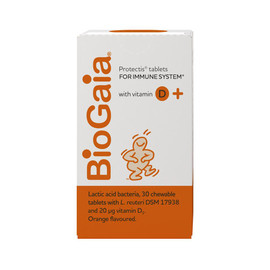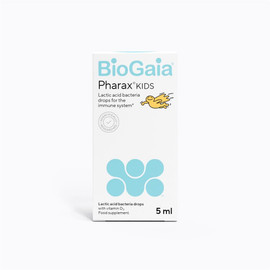Oral probiotic lozenges
With over 30 years of probiotic research, BioGaia Prodentis is a cutting-edge food supplement expertly crafted to help maintain oral health. Each minty fresh lozenge features two premium, patented bacterial strains that support a balanced oral microbiota. When combined with regular brushing and flossing, Prodentis provides a comprehensive and easy support for oral hygiene.
- One of the world's most studied probiotic for oral health*
- With Isomalt and Xylitol to help maintain strong teeth and enamel
- Supports a balanced oral microbiota
- With 30+ years of probiotic expertise
- For adults and children from 3 years of age
- Minty fresh, oral health support made easy
*According to the number of articles, PubMed Apr 2025.
What are probiotics?
Probiotics are defined as "live microorganisms that, when administered in adequate amounts, confer a health benefit on the host." (WHO/FAO 2002, Hill C et al. 2014).
Are baby probiotics safe?
Yes. All BioGaia probiotic products, including our baby probiotic drops, have been tested in clinical studies and found to be suitable and effective.
What differentiates BioGaia probiotics from other probiotics on the market?
The patented probiotic strains found in BioGaia's products were originally found to live in the human digestive tract, which means they are very well suited to our bacterial flora. Many other probiotic products on the market contain strains that come from plants or animals.
Are L. reuteri bacteria alive and growing in the product?
The bacteria are alive but in a dormant state. They become activated and fully metabolically active when they come in contact with the saliva. By the time they reach the stomach they can start to colonise.
Are multi-strain products better than single-strain probiotic products?
Multi-strain products containing several strains in high doses do not necessarily have a better effect than a single-strain product. Important criteria when choosing a probiotic product are:
- The probiotic bacteria must be defined on strain level.
- The probiotic product must have been tested in human clinical studies, with the same dose and with the same bacterial strain(s) as in the commercial product.
Why is it important to define a probiotic bacteria on strain level?
Bacteria are classified into genus, species and strains. Probiotic strains of the same species have different characteristics, and may therefore have different health effects. For example, clinical studies with the two strains, Limosilactobacillus reuteri ATCC PTA 6475 and Limosilactobacillus reuteri DSM 17938, have shown different effects in clinical studies. That is why a probiotic product must be defined on strain level.
Why is it called lactic acid bacteria if the products do not contain milk?
Many people assume that lactic acid comes from dairy because the first word sounds similar to lactose - a sugar naturally found in dairy products. However, lactic acid is not milk, nor does it contain milk. Lactic acid bacteria have the ability to form lactic acid, which is not the same as milk. Lactic acid bacteria are also found naturally in many foods, for example, in kimchi, olives and sauerkraut.
Ingredients
Bulking agent (isomalt), sweetener (xylitol), L. reuteri DSM 17938 and L. reuteri ATCC PTA 5289, peppermint flavouring and menthol flavouring.
Consumption of foods containing isomalt and xylitol instead of sugar contributes to the maintenance of tooth mineralisation
Directions
Let the lozenge melt in the mouth. Use daily for oral health. The product can be used during pregnancy and breast-feeding.
Recommended dose of 1-2 tablets daily. each tablet contains a minimum of 200 million live L. reuteri. L. reuteri DSM 17938 and L. reuteriATCC PTA 6475
Recommended daily dose should not be exceeded. Excessive consumption may produce laxative effects due to the inclusion of sweeteners in the product. This product should not be used as a substitute for a varied and balanced diet and a healthy lifestyle.
Store in a dry place, not above room temperature (max 25°C). Products should be kept out of reach of children.








